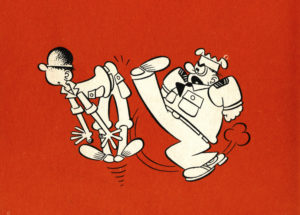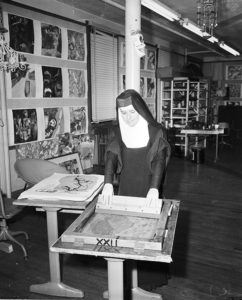
Goth animation kirby reveille consider everything an experiment…TOO MUCH in the Playhouse Comics Club this week! (The image above is the dark, a silkscreen by Corita, 1983.)
Erma, an online comic strip by Brandon J. Santiago (Outcast Comics), is about a cute little ghost girl and her family and friends. Like members of the Addams Family and the Munsters, Erma exhibits spooky supernatural powers (drifting through walls, climbing through the TV set like Sadako in the movie Ringu [1998]) even while she struggles to figure out the rules of “normal” society. See Erma freak out her schoolmates! Gawk at Erma’s collection of headless dolls! Do you have what it takes to babysit Erma? Begin reading Erma’s adventures here on the Webtoons site.
 New Zealand’s Beths, my favorite power-pop band of the last few years, have a new video out to promote the single “I’m Not Getting Excited” from their upcoming album Jump Rope Gazers, due in July. The “Excited” video, directed and animated by Callum Devlin and Annabel Kean (who call themselves “Sports Team“), is a stop-action creepy feast of spiderwebs, pink worms, floating milk cartons, and pixelated footage of the band members themselves—just the goods for a young, would-be animator.
New Zealand’s Beths, my favorite power-pop band of the last few years, have a new video out to promote the single “I’m Not Getting Excited” from their upcoming album Jump Rope Gazers, due in July. The “Excited” video, directed and animated by Callum Devlin and Annabel Kean (who call themselves “Sports Team“), is a stop-action creepy feast of spiderwebs, pink worms, floating milk cartons, and pixelated footage of the band members themselves—just the goods for a young, would-be animator.
Black Kirby, an artist team comprised of John Jennings and Stacey Robinson, mixes the aesthetics of Jack Kirby, the architect of the Marvel Universe and the most influential American comics artist, with Jennings and Robinson’s visions of an Afrocentric future full of POC superheroes, cosmic hip-hop, and African design elements. The collisions are often unexpectedly political, as in the picture here combining a famous portrait of Malcolm X with the non-assimilationist villain Magneto from Kirby and Stan Lee’s X-Men comic book. Kids who found the visual style of the animated movie Spider-Man: Into the Spider-Verse (2018) cool will enjoy browsing through Black Kirby’s Tumblr account.
 Reveille: A Family Legacy in Comics (2020) is an all-ages short movie about cartoonist Mort Walker, with sons Brian and Greg and colleague Jerry Dumas, collaborating on the comic strip Beetle Bailey, an Army comedy in newspapers since 1950. The documentary has historical value: Dumas passed away in 2016, Mort Walker in 2018, and the artisanal inking and lettering processes practiced by the Walker clan reveal how painstaking comics-making was before digital production. (Reveille was made by Dave Walker, Mort’s grandson and Brian’s son.) If you’d like to read Beetle Bailey, a week’s worth of strips are available free on Comics Kingdom, with the entire archive available for a fee.
Reveille: A Family Legacy in Comics (2020) is an all-ages short movie about cartoonist Mort Walker, with sons Brian and Greg and colleague Jerry Dumas, collaborating on the comic strip Beetle Bailey, an Army comedy in newspapers since 1950. The documentary has historical value: Dumas passed away in 2016, Mort Walker in 2018, and the artisanal inking and lettering processes practiced by the Walker clan reveal how painstaking comics-making was before digital production. (Reveille was made by Dave Walker, Mort’s grandson and Brian’s son.) If you’d like to read Beetle Bailey, a week’s worth of strips are available free on Comics Kingdom, with the entire archive available for a fee.
 Artist Frances Elizabeth “Corita” Kent was born in Fort Dodge, Iowa in 1918, graduated from the Los Angeles Catholic Girls’ High School in 1936, and immediately became a nun in the Order of the Immaculate Heart of Mary. She studied art as student at Immaculate Heart College, and discovered silkscreen printing (a technique where inks are laid onto a surface in separate layers) as a graduate student at the University of Southern California. Her artistic practice changed when, in 1962, she saw Andy Warhol’s paintings of Campbell Soup cans and fell for Pop Art, the 1950s-‘60s movement that took inspiration from the colors and designs of consumer products, newspaper advertisements, and cartoons. Corita would produce hundreds of silkscreen images and thousands of watercolors in her stripped-down, colorful, almost abstract Pop Art style; she also became a celebrity (she made the cover of Newsweek in December 1967) and left the Immaculate Heart order in 1968. Corita’s art would appear in galleries and museums, and on billboards and a U.S. postage stamp, before her death from cancer in 1986.
Artist Frances Elizabeth “Corita” Kent was born in Fort Dodge, Iowa in 1918, graduated from the Los Angeles Catholic Girls’ High School in 1936, and immediately became a nun in the Order of the Immaculate Heart of Mary. She studied art as student at Immaculate Heart College, and discovered silkscreen printing (a technique where inks are laid onto a surface in separate layers) as a graduate student at the University of Southern California. Her artistic practice changed when, in 1962, she saw Andy Warhol’s paintings of Campbell Soup cans and fell for Pop Art, the 1950s-‘60s movement that took inspiration from the colors and designs of consumer products, newspaper advertisements, and cartoons. Corita would produce hundreds of silkscreen images and thousands of watercolors in her stripped-down, colorful, almost abstract Pop Art style; she also became a celebrity (she made the cover of Newsweek in December 1967) and left the Immaculate Heart order in 1968. Corita’s art would appear in galleries and museums, and on billboards and a U.S. postage stamp, before her death from cancer in 1986.
For a much fuller timeline of Corita’s life, go here; for a generous sample of her work, go here.
In Uppercase magazine #42 (2019), Lydie Raschka wrote the following: “’Look at everything,’ Corita said, ‘Look hard.’ And I look at this common American landscape and it pops out, transformed—laundromat, liquor, mexican food, J Market, car wash, takeout, Rite Aid, Best Beer—and Corita is right: it is beautiful.”
Below: chavez, a 1969 silkscreen, and a set of rules and practices Corita wrote that were adopted by the Art Department at Immaculate Heart College in the late 1960s.
This weekly blog post is written and compiled by Craig Fischer. To send along recommendations, ideas, and comments, contact Craig at [email protected] [.]






